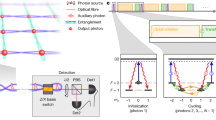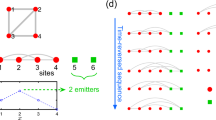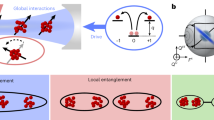Abstract
Graph states1,2,3—multipartite entangled states that can be represented by mathematical graphs—are important resources for quantum computation4, quantum error correction3, studies of multiparticle entanglement1 and fundamental tests of non-locality5,6,7 and decoherence8. Here, we demonstrate the experimental entanglement of six photons and engineering of multiqubit graph states9,10,11. We have created two important examples of graph states, a six-photon Greenberger–Horne–Zeilinger state5, the largest photonic Schrödinger cat so far, and a six-photon cluster state2, a state-of-the-art ‘one-way quantum computer’4. With small modifications, our method allows us, in principle, to create various further graph states, and therefore could open the way to experimental tests of, for example, quantum algorithms4,12 or loss- and fault-tolerant one-way quantum computation13,14.
This is a preview of subscription content, access via your institution
Access options
Subscribe to this journal
Receive 12 print issues and online access
$259.00 per year
only $21.58 per issue
Buy this article
- Purchase on SpringerLink
- Instant access to full article PDF
Prices may be subject to local taxes which are calculated during checkout




Similar content being viewed by others
References
Hein, M., Eisert, J. & Briegel, H.-J. Multiparty entanglement in graph states. Phys. Rev. A 69, 062311 (2004).
Briegel, H. J. & Raussendorf, R. Persistent entanglement in arrays of interacting particles. Phys. Rev. Lett. 86, 910–913 (2001).
Schlingemann, D. & Werner, R. F. Quantum error-correcting codes associated with graphs. Phys. Rev. A 65, 012308 (2002).
Raussendorf, R. & Briegel, H. J. A one-way quantum computer. Phys. Rev. Lett. 86, 5188–5191 (2001).
Greenberger, D. M., Horne, M. A., Shimony, A. & Zeilinger, A. Bell’s theorem without inequalities. Am. J. Phys. 58, 1131–1143 (1990).
Scarani, V. et al. Nonlocality of cluster states of qubits. Phys. Rev. A 71, 042325 (2005).
Gühne, O. et al. Bell inequalities for graph states. Phys. Rev. Lett. 95, 120405 (2005).
Dür, W. & Briegel, H.-J. Stability of macroscopic entanglement under decoherence. Phys. Rev. Lett. 92, 180403 (2004).
Nielsen, M. A. Optical quantum computation using cluster states. Phys. Rev. Lett. 93, 040503 (2004).
Browne, D. E. & Rudolph, T. Resource-efficient linear optical quantum computation. Phys. Rev. Lett. 95, 010501 (2005).
Bodiya, T. P. & Duan, L.-M. Scalable generation of graph-state entanglement through realistic linear optics. Phys. Rev. Lett. 97, 143601 (2006).
Paternostro, M. et al. Hybrid cluster state proposal for a quantum game. New J. Phys. 7, 226 (2005).
Dawson, C. M., Haselgrove, H. L. & Nielsen, M. A. Noise thresholds for optical quantum computers. Phys. Rev. Lett. 96, 020501 (2006).
Varnava, M., Browne, D. E. & Rudolph, T. Loss tolerance in one-way quantum computation via counterfactual error correction. Phys. Rev. Lett. 97, 120501 (2006).
Zhao, Z. et al. Experimental demonstration of five-photon entanglement and open-destination teleportation. Nature 430, 54–58 (2004).
Walther, P. et al. Experimental one-way quantum computing. Nature 434, 169–176 (2005).
Leibfried, D. et al. Creation of a six-atom ‘Schrödinger cat’ state. Nature 438, 639–642 (2005).
Häffner, H. et al. Scalable multiparticle entanglement of trapped ions. Nature 438, 643–646 (2005).
Walther, P., Aspelmeyer, M., Resch, K. J. & Zeilinger, A. Experimental violation of a cluster state Bell inequality. Phys. Rev. Lett. 95, 020403 (2005).
Kiesel, N. et al. Experimental analysis of a four-qubit photon cluster state. Phys. Rev. Lett. 95, 210502 (2005).
Zeilinger, A., Horne, M. A., Weinfurter, H. & Zukowksi, M. Three-particle entanglements from two entangled pairs. Phys. Rev. Lett. 78, 3031–3034 (1997).
Pan, J.-W. et al. Experimental demonstration of four-photon entanglement and high-fidelity teleportation. Phys. Rev. Lett. 86, 4435–4438 (2001).
Kwiat, P. G. et al. New high-intensity source of polarization-entangled photon pairs. Phys. Rev. Lett. 75, 4337–4341 (1995).
Zhang, Q. et al. Experimental quantum teleportation of a two-qubit composite system. Nature Phys. 2, 678–682 (2006).
Bourennane, M. et al. Experimental detection of multipartite entanglement using witness operators. Phys. Rev. Lett. 92, 087902 (2004).
Toth, G. & Gühne, O. Entanglement detection in the stabilizer formalism. Phys. Rev. A 72, 022340 (2005).
Gühne, O., Reimpell, M. & Werner, R. F. Estimating entanglement measures in experiments. Preprint at <http://arxiv.org/abs/quant-ph/0607163> (2006).
Bennett, C. H. et al. Mixed-state entanglement and quantum error correction. Phys. Rev. A 54, 3824–3851 (1996).
Dür, W., Aschauer, H. & Briegel, H.-J. Multiparticle entanglement purification for graph states. Phys. Rev. Lett. 91, 107903 (2003).
Pan, J.-W. et al. Experimental entanglement purification of arbitrary unknown states. Nature 423, 417–422 (2003).
Acknowledgements
We thank H. J. Briegel, D. Browne, L.-M. Duan, T. Rudolph and S. Yu for helpful discussions. This work was supported by the National Natural Science Foundation of China, the Chinese Academy of Sciences. This work was also supported by the Alexander von Humboldt Foundation, the Marie Curie Excellence Grant of the EU, the FWF, the DFG and EU (Scala, Olaqui, Prosecco, QICS, Quprodis).
Author information
Authors and Affiliations
Corresponding authors
Ethics declarations
Competing interests
The authors declare no competing financial interests.
Supplementary information
Rights and permissions
About this article
Cite this article
Lu, CY., Zhou, XQ., Gühne, O. et al. Experimental entanglement of six photons in graph states. Nature Phys 3, 91–95 (2007). https://doi.org/10.1038/nphys507
Received:
Accepted:
Published:
Issue date:
DOI: https://doi.org/10.1038/nphys507
This article is cited by
-
Combating errors in quantum communication: an integrated approach
Scientific Reports (2023)
-
Distributed exact Grover’s algorithm
Frontiers of Physics (2023)
-
Chip-based photonic graph states
AAPPS Bulletin (2023)
-
A QDS scheme based on superdense teleportation
Quantum Information Processing (2022)
-
The Criterion of Maximally Four- and Five-Qubit Entangled States via Monogamy Linear Entropy Relations
International Journal of Theoretical Physics (2022)



